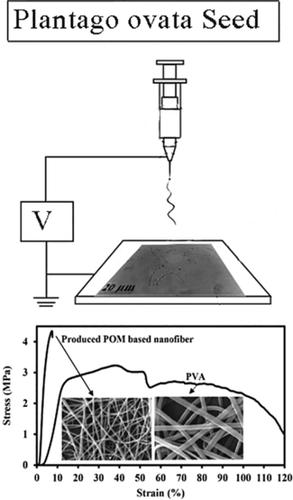当前位置:
X-MOL 学术
›
J. Appl. Polym. Sci.
›
论文详情
Our official English website, www.x-mol.net, welcomes your
feedback! (Note: you will need to create a separate account there.)
A comprehensive study on Plantago ovata/PVA biocompatible nanofibers: Fabrication, characterization, and biological assessment
Journal of Applied Polymer Science ( IF 2.7 ) Pub Date : 2020-07-03 , DOI: 10.1002/app.49560 Ali Reza Allafchian 1, 2 , Sahar Kalani 1 , Pooran Golkar 2, 3 , Hassan Mohammadi 1 , Seyed Amir Hossein Jalali 2, 3
Journal of Applied Polymer Science ( IF 2.7 ) Pub Date : 2020-07-03 , DOI: 10.1002/app.49560 Ali Reza Allafchian 1, 2 , Sahar Kalani 1 , Pooran Golkar 2, 3 , Hassan Mohammadi 1 , Seyed Amir Hossein Jalali 2, 3
Affiliation

|
In this study, a biocompatible nanofiber is fabricated using Plantago ovata mucilage (POM) combined with polyvinyl alcohol (PVA), which is considered as a non‐toxic polymer. High quality nanofibers were produced by controlling the electrospinning parameters after selecting an appropriate solvent for the POM/PVA combination (12% PVA and 3% POM). Electrospinning parameters, including high voltage, distance from collector to tip, feed rate and POM to PVA proportion were optimized following preparation of an aqueous POM/PVA solution. Using the results of scanning electron microscopy, the optimized electrospinning conditions for producing POM/PVA nanofibers were determined (high voltage = 18 kV, distance = 15 cm, feed rate = 0.125 ml/hr, PMM/PVA = 50/50) and uniform nanofibers with an average diameter of 250 nm were produced. The POM/PVA nanofiber sample was evaluated by determining the mechanical strength, characterization of produced nanofiber morphology, and investigating the cell viability by applying MTT assay. The bands for both POM and PVA from FTIR results showed that the samples remained stable. The tensile strength results showed that blending POM with PVA solution enhanced the Young's modulus by factor of 3.2 (0.2 MPa to 0.64 MPa). The MTT analysis on POM/PVA cell lines proved that the produced nanofiber considerably enabled the cellular proliferation. Enhancement in these analysis indicated how POM‐based nanofibers is a promising scaffold for cell culture, drug delivery systems and food additives.
中文翻译:

车前子/ PVA生物相容性纳米纤维的全面研究:制备,表征和生物学评估。
在这项研究中,使用车前子(Plantago ovata)制造了生物相容性纳米纤维。粘液(POM)与聚乙烯醇(PVA)结合使用,被认为是无毒的聚合物。在为POM / PVA组合选择合适的溶剂(12%PVA和3%POM)之后,通过控制电纺丝参数,可以生产出高质量的纳米纤维。在制备POM / PVA水溶液后,对静电纺丝参数进行了优化,包括高压,从集电器到尖端的距离,进料速率以及POM与PVA的比例。使用扫描电子显微镜的结果,确定了用于生产POM / PVA纳米纤维的最佳电纺条件(高压= 18 kV,距离= 15 cm,进料速度= 0.125 ml / hr,PMM / PVA = 50/50)并且均匀产生平均直径为250nm的纳米纤维。通过确定机械强度来评估POM / PVA纳米纤维样品,表征所产生的纳米纤维形态,并通过应用MTT分析研究细胞活力。FTIR结果的POM和PVA谱带均显示样品保持稳定。拉伸强度结果表明,将POM与PVA溶液共混可使杨氏模量提高3.2倍(0.2 MPa至0.64 MPa)。对POM / PVA细胞系的MTT分析证明,产生的纳米纤维大大促进了细胞增殖。这些分析的增强表明,基于POM的纳米纤维如何成为细胞培养,药物递送系统和食品添加剂的有前途的支架。拉伸强度结果表明,将POM与PVA溶液共混可使杨氏模量提高3.2倍(0.2 MPa至0.64 MPa)。对POM / PVA细胞系的MTT分析证明,产生的纳米纤维大大促进了细胞增殖。这些分析的增强表明,基于POM的纳米纤维如何成为细胞培养,药物递送系统和食品添加剂的有前途的支架。拉伸强度结果表明,将POM与PVA溶液共混可使杨氏模量提高3.2倍(0.2 MPa至0.64 MPa)。对POM / PVA细胞系的MTT分析证明,产生的纳米纤维可以使细胞增殖。这些分析的增强表明,基于POM的纳米纤维如何成为细胞培养,药物递送系统和食品添加剂的有前途的支架。
更新日期:2020-07-03
中文翻译:

车前子/ PVA生物相容性纳米纤维的全面研究:制备,表征和生物学评估。
在这项研究中,使用车前子(Plantago ovata)制造了生物相容性纳米纤维。粘液(POM)与聚乙烯醇(PVA)结合使用,被认为是无毒的聚合物。在为POM / PVA组合选择合适的溶剂(12%PVA和3%POM)之后,通过控制电纺丝参数,可以生产出高质量的纳米纤维。在制备POM / PVA水溶液后,对静电纺丝参数进行了优化,包括高压,从集电器到尖端的距离,进料速率以及POM与PVA的比例。使用扫描电子显微镜的结果,确定了用于生产POM / PVA纳米纤维的最佳电纺条件(高压= 18 kV,距离= 15 cm,进料速度= 0.125 ml / hr,PMM / PVA = 50/50)并且均匀产生平均直径为250nm的纳米纤维。通过确定机械强度来评估POM / PVA纳米纤维样品,表征所产生的纳米纤维形态,并通过应用MTT分析研究细胞活力。FTIR结果的POM和PVA谱带均显示样品保持稳定。拉伸强度结果表明,将POM与PVA溶液共混可使杨氏模量提高3.2倍(0.2 MPa至0.64 MPa)。对POM / PVA细胞系的MTT分析证明,产生的纳米纤维大大促进了细胞增殖。这些分析的增强表明,基于POM的纳米纤维如何成为细胞培养,药物递送系统和食品添加剂的有前途的支架。拉伸强度结果表明,将POM与PVA溶液共混可使杨氏模量提高3.2倍(0.2 MPa至0.64 MPa)。对POM / PVA细胞系的MTT分析证明,产生的纳米纤维大大促进了细胞增殖。这些分析的增强表明,基于POM的纳米纤维如何成为细胞培养,药物递送系统和食品添加剂的有前途的支架。拉伸强度结果表明,将POM与PVA溶液共混可使杨氏模量提高3.2倍(0.2 MPa至0.64 MPa)。对POM / PVA细胞系的MTT分析证明,产生的纳米纤维可以使细胞增殖。这些分析的增强表明,基于POM的纳米纤维如何成为细胞培养,药物递送系统和食品添加剂的有前途的支架。











































 京公网安备 11010802027423号
京公网安备 11010802027423号